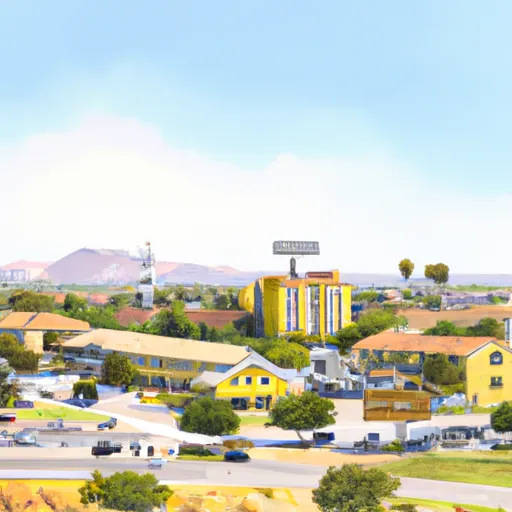-
 Snoflo Premium
Snoflo Premium
Get unlimited access to all our content
With no Ad interruptions! - Start Your Free Trial Login with existing account
Zenia
Eden Index
Climate
8.4
•
Recreation
4.4
•
Community
0.7
•
Safeguard
5.1/10

Zenia, California is a small town located in Humboldt County in the northwestern part of the state. The town experiences a Mediterranean climate with mild, wet winters and warm, dry summers. Average temperatures range from the mid-40s°F (7°C) in winter to the mid-80s°F (30°C) in summer. Annual precipitation is around 50 inches, with the majority falling between October and April.
Zenia benefits from its proximity to the Eel River, which provides ample water for various outdoor activities. The river is known for its diverse hydrology constituents, including steelhead trout, chinook salmon, and other aquatic species. Fishing enthusiasts can enjoy angling for these species or simply appreciate the serene beauty of the river.
Outdoor recreation opportunities in Zenia are abundant. The surrounding area offers scenic hiking trails, perfect for exploring the redwood forests and enjoying breathtaking views. Mountain biking is also popular, with trails catering to different skill levels. The nearby Eel River provides opportunities for swimming, kayaking, and canoeing. Additionally, the town is close to several state parks and recreational areas, offering visitors the chance to camp, picnic, and connect with nature. Zenia is a nature lover's paradise, providing a diverse range of activities for visitors to enjoy.
What is the Eden Index?
The Snoflo Eden Index serves as a comprehensive rating system for regions, evaluating their desirability through a holistic assessment of climate health, outdoor recreation opportunities, and natural disaster risk, acknowledging the profound impact of these factors on livability and well-being.
Climate Health Indicator (CHI): 8.4
Zenia receives approximately
1684mm of rain per year,
with humidity levels near 78%
and air temperatures averaging around
13°C.
Zenia has a plant hardyness factor of
9, meaning
plants and agriculture in this region tend to thrive here all year round.
By considering the ideal temperature range, reliable water supplies, clean air, and stable seasonal rain or snowpacks, the Climate Health Indicator (CHI) underscores the significance of a healthy climate as the foundation for quality living.
A healthy climate is paramount for ensuring a high quality of life and livability in a region, fostering both physical well-being and environmental harmony. This can be characterized by ideal temperatures, reliable access to water supplies, clean air, and consistent seasonal rain or snowpacks.
Weather Forecast
Streamflow Conditions
Northern California Coastal
Area Rivers
Northern California Coastal
Snowpack Depths
Northern California Coastal
Reservoir Storage Capacity
Northern California Coastal
Groundwater Levels
Recreational Opportunity Index (ROI): 4.4
The Recreational Opportunity Index (ROI) recognizes the value of outdoor recreational options, such as parks, hiking trails, camping sites, and fishing spots, while acknowledging that climate plays a pivotal role in ensuring the comfort and consistency of these experiences.
Access to outdoor recreational opportunities, encompassing activities such as parks, hiking, camping, and fishing, is crucial for overall well-being, and the climate plays a pivotal role in enabling and enhancing these experiences, ensuring that individuals can engage in nature-based activities comfortably and consistently.
Camping Areas
| Campground | Campsites | Reservations | Toilets | Showers | Elevation |
|---|---|---|---|---|---|
| Miller Spring | 5 | 4,717 ft | |||
| Bailey Canyon | 25 | 2,719 ft | |||
| Mad River | 40 | 2,559 ft | |||
| Forest Glen | 21 | 2,450 ft | |||
| Scott Flat | 18 | 2,381 ft | |||
| Fir Cove | 19 | 2,763 ft | |||
| Hell Gate | 29 | 2,341 ft |
Nearby Ski Areas
Catastrophe Safeguard Index (CSI):
The Catastrophe Safeguard Index (CSI) recognizes that natural disaster risk, encompassing floods, fires, hurricanes, and tornadoes, can drastically affect safety and the overall appeal of an area.
The level of natural disaster risk in a region significantly affects safety and the overall livability, with climate change amplifying these risks by potentially increasing the frequency and intensity of events like floods, fires, hurricanes, and tornadoes, thereby posing substantial challenges to community resilience and well-being.
Community Resilience Indicator (CRI): 0.7
The Community Resilience Indicator (CRI) recognizes that education, healthcare, and socioeconomics are crucial to the well-being of a region. The CRI acknowledges the profound impact of these elements on residents' overall quality of life. By evaluating educational resources, healthcare accessibility, and economic inclusivity, the index captures the essential aspects that contribute to a thriving community, fostering resident satisfaction, equity, and social cohesion.

